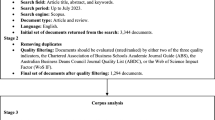Abstract
Reputation has many interpretations, but most agree that it is an intangible asset that can build competitive advantage for a firm. This paper takes a dynamic resource-based view of reputation and argues that the best way to understand how it contributes to competitive advantage is through a systems approach. The systems thinking approach is concerned with developing and testing operational explanations of organizational behavior. It differs from the traditional approach as it requires an understanding of the ‘whole’ through the relationships between ‘organizational’ pieces. The traditional approach is based on an understanding of the whole by understanding the individual pieces. This paper offers an explanation of the systems approach starting with a basic understanding of causal loop diagrams and stock and flow diagrams, progressing into the more complicated modeling of behavior and interactions. How reputation plays a role in a hypothetical example of the hiring process, often referred to as employer branding, is used to illustrate how the approach can be applied in reputation management. Systems thinking is recognized as a quality approach to organizations but one that is complicated and that has been slow to be adopted by organizations. Some insights into how to employ the approach are offered at the end of the paper.










Similar content being viewed by others
References
Barnett, M.L., Jermier, L.M. and Lafferty, B.A. (2006) ‘Corporate reputation: The definitional landscape’, Corporate Reputation Review, 9 (1), 26–38.
Barney, J.B. (1986) ‘Strategic factor markets: Expectations, luck and business strategy’, Management Science, 32 (10), 1231–1241.
Barney, J.B. (1991) ‘Firm resources and sustained competitive advantage’, Journal of Management, 17 (1), 99–120.
Bennett, R. and Kottasz, R. (2000) ‘Practitioner perceptions of corporate reputation: An empirical investigation’, Corporate Communications: An International Journal, 5 (4), 224–234.
Davis, A. and O’Donnell, L. (1997) Modeling complex problems: System dynamics and performance measurement. Management Accounting Chartered Institute of Management Accountants (CIMA). HighBeam Research. http://www.highbeam.com, accessed 30 June 2014.
Dierickx, I. and Cool, K. (1989) ‘Asset stock accumulation and sustainability of competitive advantage’, Management Science, 35 (12), 1504–1511.
Doorley, J. and Garcia, H.F. (2007) Reputation Management: The Key to Successful Public Relations and Corporate Communication, Routledge, New York.
Dowling, G. and Moran, P. (2012) ‘Corporate reputations: Built in or bolted on?’ California Management Review, 54 (2), 25–42.
Figge, F., Hahn, T., Schaltegger, S. and Wagner, M. (2002) ‘The sustainability balanced scorecard – Linking sustainability management to business strategy’, Business Strategy and the Environment, 11 (5), 269–284.
Fombrun, C.J and van Riel, C.B.M. (1997) ‘The reputational landscape’, Corporate Reputation Review, 1 (1/2), 5–13.
Forrester, J.W. (1971) ‘Counterintuitive behavior of social systems’, Theory and Decision, 2 (2), 109–140.
Kaplan, R.S. (2005) ‘How the balanced scorecard complements the McKinsey 7- S model’, Strategy & leadership, 33 (3), 41–46.
Kraatz, M.S. and Love, E.G. (2006) ‘Studying the dynamics of reputation – A framework for research on the reputational consequences of corporate actions’, in D. Kitchen and D. Bergh (eds.), Research Methodology in Strategy and Management Vol. 3, JAI Press: Greenwich, CT, pp. 343–383.
Morecroft, J.D.W. (1984) ‘Strategy support models’, Strategic Management Journal, 5 (3), 215–229.
Morecroft, J.D.W, Larsen, E.R., Lomi, A. and Ginsberg, A. (1995) ‘The dynamics of resource sharing: A metaphorical model’, System Dynamics Review, 11 (4), 289–309.
Morecroft, J.D.W. and Sterman, J.D. (eds.) (1994) Modeling for Learning Organizations, Productivity Press, New York.
Peloza, J. (2006) ‘Using corporate social responsibility as insurance for financial performance’, California Management Review, 48 (2), 52–72.
Prahalad, C.K. and Bettis, R.A. (1986) ‘The dominant logic: A new linkage between diversity and performance’, Strategic Management Journal, 7 (6), 485–501.
Roberts, P. W. and Dowling, G. (2002) ‘Corporate reputation and sustained superior financial performance’, Strategic Management Journal, 23 (12), 1077–1093.
Ross, R.B. (1994) ‘The ladder of inference’, in P.M. Senge, A. Kleiner, C. Roberts, R.B. Ross and B.J. Smith (eds.), The Fifth Discipline Fieldbook: Strategies and Tools for Building a Learning Organization, Crown Business, New York, pp. 242–246.
Ruben, B.D., Lederman, L. and Gibson, D.W. (2000) Communication Theory: A Casebook Approach, Kendall Hunt, Dubuque, IA.
Sanchez, R. and Heene, A. (1996) ‘A systems view of the firm in competence-based competition’, in R. Sanchez, A. Heene and H. Thomas (eds.), Dynamics of Competence Based Competition: Theory and Practice in the New Strategic Management, Pergamon, Oxford.
Schwenk, C.R. (1984) ‘Cognitive simplification processes in strategic decision-making’, Strategic Management Journal, 5 (2), 111–128.
Sterman, J.D. (1989) ‘Modeling managerial behavior: Misperceptions of feedback in a dynamic decision making experiment’, Management Science, 35 (3), 321–339.
Sterman, J.D. (2000) Business Dynamics: Systems Thinking and Modeling in a Complex world, Irwin McGraw-Hill, Boston MA.
Warren, K. (1999a) ‘The dynamics of strategy’, Business Strategy Review, 10 (3), 1–16.
Warren, K. (1999b) ‘The dynamics of rivalry’, Business Strategy Review, 10 (4), 41–54.
Warren, K. (2000) ‘The softer side of strategy dynamics’, Business Strategy Review, 11 (1), 45–58.
Weick, K.E., Sutcliffe, K.M. and Obstfeld, D. (2005) ‘Organizing and the process of sensemaking’, Organization Science, 16 (4), 409–421.
Van Riel, C.B.M. and Fombrun, C.J. (2007) Essentials of Corporate Communication, Routledge, Oxford, UK.
Vennix, J.A.M. (1996) Group Model Building – Facilitating Team Learning Using System Dynamics, John Wiley and Sons, Chichester.
Author information
Authors and Affiliations
Rights and permissions
About this article
Cite this article
Brønn, C., Brønn, P. A Systems Approach to Understanding how Reputation Contributes to Competitive Advantage. Corp Reputation Rev 18, 69–86 (2015). https://doi.org/10.1057/crr.2015.5
Published:
Issue Date:
DOI: https://doi.org/10.1057/crr.2015.5




